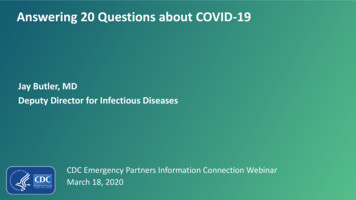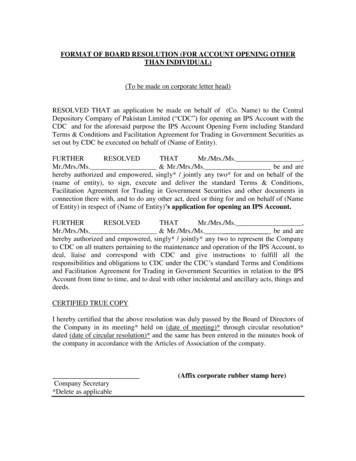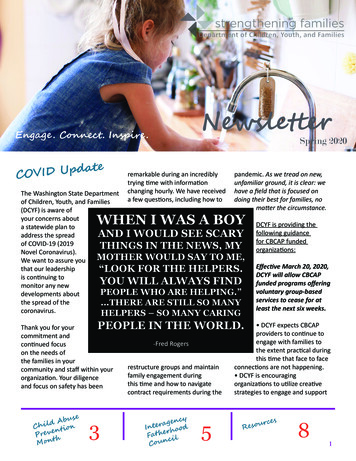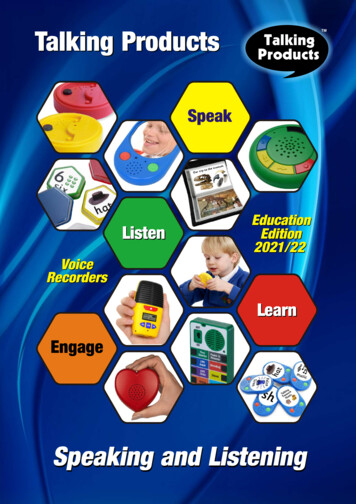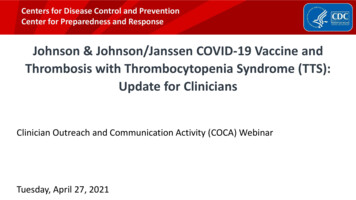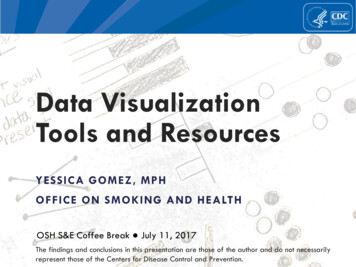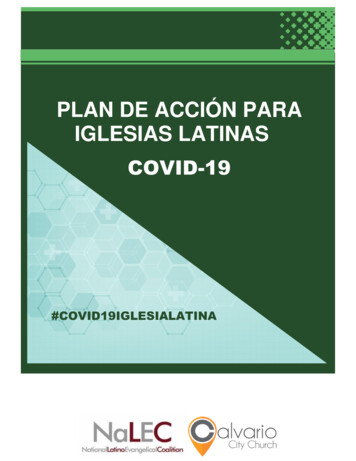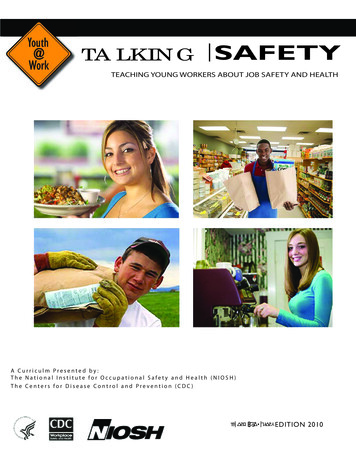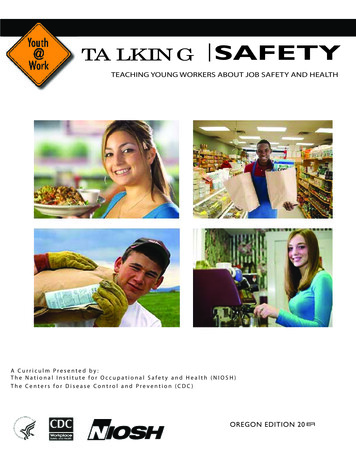
Transcription
TALKING SAFETYTEACHING YOUNG WORKERS ABOUT JOB SAFETY AND HEALTHA Curriculm Presented by:The National Institute for Occupational Safety and Health (NIOSH)The Centers for Disease Control and Prevention (CDC)OREGON EDITION 20
TALKING SAFETYTEACHING YOUNG WORKERS ABOUT JOB SAFETY AND HEALTHOREGON EDITIONA joint publication of . . .Centers for Disease Control and PreventionNational Institute for Occupational Safety and HealthLabor Occupational Health ProgramUniversity of California, BerkeleyEducation Development Center, Inc.20
Preface/IntroductionNIOSH is pleased to present Youth @ Work—Talking Safety, a foundation curriculum in occupationalsafety and health. This curriculum is the culmination of many years’ work by a consortium of partnersdedicated to reducing occupational injuries and illnesses among youth. The initial curricula upon whichYouth @ Work—Talking Safety is based included WorkSafe!, developed by the Labor Occupational HealthProgram (LOHP) at the University of California, Berkeley, and Safe Work/Safe Workers, developed by theOccupational Health Surveillance Program at the Massachusetts Department of Public Health and theEducation Development Center, Inc. (EDC) in Newton, MA. Those products were produced under grantsfrom NIOSH as well as the Occupational Safety and Health Administration, US Department of Labor; theMassachusetts Department of Industrial Accidents; the Maternal and Child Health Bureau, HealthResources and Services Administration; and Liberty Mutual Insurance Company.The activities in the Youth @ Work curriculum were developed in consultation with numerous teachersand staff from general high schools, school to work, work experience, and vocational education programs,as well as the California WorkAbility program, which serves students with cognitive and learningdisabilities. The activities have been extensively pilot tested and used by numerous high school teachers,job trainers, and work coordinators around the country to teach youth important basic occupational safetyand health skills. In 2004, NIOSH made a commitment to integrate an occupational safety and healthcurriculum into US high schools. As part of this effort, the States’ Career Clusters Initiative which operatesunder the auspices of the National Association of State Directors of Career Technical Education consortium(NASDCTEc) joined the partnership. The Youth @ Work curriculum was evaluated in sixteen schoolsacross ten states during the 2004-2005 school year. This final version reflects the input from all of theteachers, administrators, students, and partners who participated in that evaluation.AuthorsYouth @ Work was based on materials originally authored by Diane Bush, Robin Dewey, and Betty Szudyof LOHP and Christine Miara of EDC. Additional contributors to Youth @ Work include Dr. CarolStephenson, Dr. Andrea Okun, and Dr. Ted Fowler of NIOSH, and Dr. Frances Beauman from IllinoisOffice of Educational Services at Southern Illinois University.AcknowledgementsThis curriculum was developed under the leadership of Dr. Paul Schulte, Director of the Educationand Information Division at NIOSH. Funds were also provided by grant number H610-HT12 from theOccupational Safety and Health Administration (OSHA), US Department of Labor. Editors of thiscurriculum were Gene Darling (LOHP) and John Diether (NIOSH). Graphic and layout editor was KateOliver (LOHP), and illustrations provided by Mary Ann Zapalac (LOHP) and Pat Haskins (NIOSH).Technical reviewers included Dr. Letitia Davis (MA Department of Public Health), Mary Miller (WADepartment of Labor and Industries), Elise Handelman (OSHA), and representatives of variousprofessional and educational organizations such as the American Industrial Hygiene Association, TheAmerican Society of Safety Engineers, and the National Safety Council. Additional NIOSH contributors tothe 2010 version include Rebecca Guerin (content editor) and Stephen Leonard (web designer desktoppublisher).We would like to thank the many teachers, administrators, and students from the participating schools andstates who evaluated the 2004-2005 pilot curriculum:Youth @ Work: TTalkingalking SafetyWork:SafetyIntroduction–Page iiIntroductionoduction–P–Page
East Valley Institute of Technology, Mesa, AZTampa Bay Technical High School, Tampa, FLMid Florida Tech, Orlando, FLWest Florida High School of Advanced Technology, Pensacola, FLProfessional/Technical Education Center (PTEC), Boise, IDHerrin High School, Herrin, ILKankakee Valley High School, Wheatfield, INMillcreek Center, Olathe, KSLandry High School, New Orleans, LAMandeville High School, Mandeville, LAWalker High School, Walker, LALewis & Clark Career Center, St. Charles, MOWhitmer High School, Toledo, OHLenepe Technical School, Ford City, PAState College Area School District & CTE Center, State College, PADisclaimers:Mention of any company or product does not constitute endorsement by the National Institutefor Occupational Safety and Health (NIOSH). In addition, citations to Web sites external toNIOSH do not constitute NIOSH endorsement of the sponsoring organizations or theirprograms or products. Furthermore, NIOSH is not responsible for the content of these Websites.Youth @ Work — TDONLQJ 6DIHW\ LV HQGRUVHG E\ WKH 6WDWHV· &DUHHU &OXVWHUV ,QLWLDWLYH (QGRUVHPHQWGRHV QRW FDUU\ ZLWK LW DQ\ OHJDO ILVFDO SROLF\ RU RWKHU UHVSRQVLELOLW\ RU OLDELOLW\ E\ WKH HQGRUVHU IRU WKLVSURGXFW (QGRUVHPHQW PHDQV WKH SURGXFW DOLJQV WR DQG VXSSRUWV WKH JHQHUDO VSLULW LQWHQW DQG JRDOV RI WKH6WDWHV· &DUHHU &OXVWHUV ,QLWLDWLYH (QGRUVHPHQW GRHV QRW LPSO\ SULRULW\ RU SUHIHUHQFH RI DQ\ SURGXFW ZZZ FDUHHUFOXVWHUV RUJReaders are free to duplicate any and all parts of this publication; however, in accordance withstandard publishing practices, NIOSH appreciates acknowledgement of any information reproduced.For more information:NIOSHwww.cdc.gov/nioshYouth @ Work: TTalkingalking SafetyWork:Safety–Page iiiIntroductionIntroductionoduction–P–Page
Labor Occupational Health Program (LOHP)University of California at Berkeley2223 Fulton StreetBerkeley, CA 94720-5120Phone: (510) 642-5507Fax: (510) 643-5698www.lohp.orgE-mail: lohp@socrates.berkeley.eduEducation Development Center, Inc. (EDC)55 Chapel Street, Newton, Massachusetts 02458-1060Phone: (617) 969-7100Fax: (617) 969-5979TTY: (617) 964-5448www.edc.orgCareer Clusters www.careerclusters.orgNational Association of State Directors of Career Technical Education Consortium (NASDCTEc)www.careertech.orgPub no 2007-136(OR)Youth @ Work: TTalkingalking SafetyWork:SafetyIntroduction–Page ivIntroductionoduction–P–Page
Table of ContentsIntroduction .viLessons1. Young Worker Injuries . 12. Finding Hazards . 113. Finding Ways To Make the Job Safer . 214. Emergencies at Work . 455. Know Your Rights . 576. Taking Action . 67OverheadsOverheadsStudent HandoutsAppendicesA. Optional Student Handout: Hazards in Typical Teen JobsB. &HUWLILFDWH RI &RPSOHWLRQYouth @ Work: TTalkingalking SafetyWork:SafetyIntroduction–Page vIntroductionoduction–P–Page
IntroductionWhy TTeacheach Young Workers About Job Safety and Health?WorkersJobSafetyMillions of teens in the United States work. Surveys indicate that 80% of teens have workedby the time they finish high school. While work provides numerous benefits for youngpeople, it can also be dangerous. Every year, approximately ,000 youth are injured on thejob seriously enough to seek emergency room treatment. In fact, teens are injured at a higherrate than adult workers.As new workers, adolescents are likely to be inexperienced and unfamiliar with many of thetasks required of them. Yet despite teen workers’ high job injury rates, safety at work isusually one of the last things they worry about. Many of teens’ most positive traits—energy,enthusiasm, and a need for increased challenge and responsibility—can result in their takingon tasks they are not prepared to do safely. They may also be reluctant to ask questions ormake demands on their employers.Health and safety education is an important component of injury prevention for workingteens. While workplace-specific training is most critical, young people also need theopportunity to learn and practice general health and safety skills that they will carry withthem from job to job. Teens should be able to recognize hazards in any workplace. Theyshould understand how hazards can be controlled, what to do in an emergency, what rightsthey have on the job, and how to speak up effectively when problems arise at work.School and community-based programs that place youth in jobs offer an important venue forteaching these skills. One national program that recognizes the importance of including theseskills as part of the educational experience is the Career Cluster Initiative, developed by theU.S. Department of Education Office of Vocational and Adult Education (OVAE) andcurrently being implemented in a number of states. OVAE identified 16 career clusters thatinclude the major job opportunities in today’s workforce. Examples of clusters are finance,architecture and construction, and health science. (For a complete list of career clusters, seewww.careerclusters.org.) Each cluster has a curriculum framework and a set of coreknowledge and skills students should master, which includes workplace health and safety.Youth @ Work: TTalkingalking SafetyWork:SafetyThis curriculum has been designed to teach core health and safety skills and knowledge,covering basic information relevant to any occupation.The learning activities in this curriculum are intended to raise awareness among young peopleabout occupational safety and health and provide them with the basic skills they need tobecome active participants in creating safe and healthy work environments.Youth @ Work: TTalkingalking SafetyWork:SafetyIntroduction–Page viIntroductionoduction–P–Page
The activities highlight hazards and prevention strategies from a wide variety of workplaces.The materials are very flexible. They may be used as a stand-alone curriculum or may beincorporated into other safety programs. Teachers who have used this curriculum indicated thatthe material was an excellent introduction to other safety instruction such as the OSHA 10-hourcourse or occupational specific safety instruction. They also said it could be used to enhanceother safety programs. Educators can tailor the curriculum to students in a specific careercluster by selecting the workplace examples and scenarios provided which are most relevant tothat career cluster.This curriculum has been endorsed by the U.S. Department of Education’s Career ClusterInitiative, Job Corps, and Skills USA.Overview of the CurriculumYouth @ Work: Talking Safety is designed to help teachers, as well as school and communitybased job placement staff, give young people the basics of job health and safety in a fun andinteresting way. The curriculum presents essential information and skills through a focus on sixtopic areas:Lesson 1, Young Worker Work Injuries, assesses students’ current knowledge of job safetyand legal rights. It also introduces students to these issues and emphasizes the impact a jobinjury can have on a young person’s life.Lesson 2, Finding Hazards, develops an understanding of the common health and safetyhazards that teens may face on the job.Lesson 3, Finding Ways To Make the Job Safer, explains measures that can reduce oreliminate hazards on the job. It also shows students how to get more information aboutspecific hazards they may face and on how to control them.Lesson 4, Emergencies at Work, introduces students to the various types of emergenciesthat may occur in a workplace, and how the employer and workers should respond tothem.Lesson 5, Know Your Rights, focuses on the legal rights all workers have under health andsafety laws, the special rights young workers have under child labor laws, and thegovernment agencies and other resources that can help. Be sure to obtain the version of thiscurriculum that is specific to your state because some laws and agency names vary fromstate to state. Download from: www.cdc.gov/NIOSH.Lesson 6, Taking Action, helps develop skills in speaking up effectively if a problemarises at work.Lesson Plans, Overheads, and Student Handouts are provided for all six lessons. The1 -minute video presented in Lesson 1 is also included. The Appendix includes an optionalhandout which gives more information about hazards in typical teen jobs. A Certificate ofCompletion is also provided and may be photocopied.Youth @ Work: TTalkingalking SafetyWork:SafetyIntroduction–Page viiIntroductionoduction–P–Page
Lessons may be presented together or over several class periods. Included in each lesson are: Learning Objectives (what the students will learn). A Lesson Plan chart with a short summary of the activities included, the time requiredfor each activity, and the materials needed. A section titled Preparing To Teach This Lesson, with a list of steps to follow whenyou prepare—obtain equipment, prepare handouts, etc. Detailed Instructor’s Notes with complete teaching instructions. Tips for a Shorter Lesson (suggestions for covering the material in less time).Each lesson begins with an introductory discussion, followed by two or three participatorylearning activities for teaching the concepts of that lesson. At least one of the learning activitiesin each lesson is very basic, with minimal or no reading required, and is designed to meet theneeds of all students. Several of these activities have been developed for, and pilot tested with,students who have cognitive and learning disabilities.As you prepare to teach this course, look through all the activities that make up each lesson.Select the activities that you feel will be most effective with your particular students. Thecurriculum is very flexible and gives you many alternatives from which to choose.The time required for each activity within a lesson is shown in the Lesson Plan chart at thebeginning of the lesson. This entire course can be taught in three to five hours, dependingupon whether you teach one activity, or all activities, from each lesson. If you have less thanthree hours to devote to this topic, consult the section at the end of each lesson called “Tipsfor a Shorter Lesson.”Youth @ Work: TTalkingalking SafetyWork:SafetyIntroduction–Page viiiIntroductionoduction–P–Page
LESSON ONEYOUNG WORKER INJURIESLearning ObjectivesBy the end of this lesson, students will be able to:Determine how much they already know about job safety and their legalrights.Describe the impact work injuries can have on a young person’s life.Identify the major messages in a video on teen job safety.Define the word “hazard” and identify possible health and safetyhazards in the workplaces shown in the video.Youth @ Work: Talking SafetyLesson One—Page 1
Lesson Plan OneActivityA. Overheads #1–5.10 minutes Overhead #6. Student Handout #1.15 minutes Video, DVD Player,and TV.5 minutes Overhead #7.Goals of this trtraining.aining.Instructor explains the goals of this series of classes.Youth Flipchart & markers,or chalkboard & chalk.Video and discussion.The instructor leads a class discussion about theissues raised in the video, Teen Workers: Real Jobs,Real Risks.D.15 minutesYour safety IQ quiz.Students work together in small groups on a quizthat tests their current safety knowledge. The wholeclass then reviews answers.C.MaterialsIntroduction: Young workers and safetyIntroduction:safety.Students participate in a “warm-up” discussionabout what jobs they have had, and whether theyhave ever been injured at work.B.Time@alking SafetySafetyWork:Work: TTalkingLesson One—Page 2
Preparing TToo TTeacheach This LessonBefore you present Lesson One:1. Obtain a flipchart and markers, or use a chalkboard and chalk.2. Copy each Overhead used in this lesson (#1–7) onto a transparency toshow with an overhead projector.3. Photocopy Student Handout #1, Your Safety IQ Quiz, for each student.4. Obtain a DVD Player and TV.5. Preview the provided video Teen Workers: Real Jobs, Real Risks.s NotesDetailed Instructor’Instructor’sA. Introduction: Young workers and safetyIntroduction:safety.(15 minutes)1. Explain that this is a series of classes about staying safe at work. Manyteens have jobs, and sometimes their work is dangerous. Students in theseclasses will learn about:Youth@alking SafetyWork: TTalkingSafetyWork: Some of the ways people (both youth and adults) can get hurt on thejob. What to do if you see something at work that could hurt you ormake you sick. What legal rights all workers have to make sure their jobs are safe. What extra protections young workers have under child labor laws.Lesson One—Page 3
2. As a warm-up discussion, ask students: How many of you have ever had a job? Where did you work? What did you do? Have you ever been hurt at work, or do you know someone who was? Have you ever been afraid about a task you’ve been asked to do atwork? Let the class briefly discuss their answers. The questions are designed to getstudents thinking about safety issues in their own job experience.ShowOverhead#13. To emphasize the impact work injuries can have on a young person’s life,tell about an actual news story from your state or read the class at least oneof the stories below. Or you can select stories from Lesson 3 (B), the 25,000 Safety Pyramid game (pages 28–33). All stories are based oninjuries that actually occurred.ShowOverhead#2ShowOverhead#3John worked at a fast food restaurant. The floor often got very greasy,and had to be washed a lot. As John walked across the wet floor,carrying a basket of french fries, he slipped. He tried to keep the friesfrom falling, so he couldn’t break his fall with his hands. He fell on histailbone and was seriously injured. He is now permanently disabled andhas trouble walking.Antonio worked for a neighborhood builder. One day when he wascarrying a 12-foot roof rafter along the top of an unfinished house, hebacked into an unguarded chimney hole and plunged 28 feet to aconcrete cellar floor below. He survived, but with three crackedvertebrae that forced him to spend the next three months locked in a“clamshell” brace from his neck to his hips.Keisha did much of her homework on the computer and spent time eachday e-mailing her friends. In addition, she worked three hours a dayafter school inputting data for a direct mail company. She was paid by“piece work” (by the amount of work, not the amount of time). Shenever took breaks. She began getting numbness in her fingers andwaking up with a burning sensation in her wrist. Her doctor told her shehas severe repetitive stress injury (RSI), in which prolonged typing inYouth@alking SafetySafetyWork:Work: TTalkingLesson One—Page 4
an awkward position damages muscles, tendons, and nerves. She nowmust wear braces on her wrists day and night and can’t work on thecomputer for more than 15 minutes at a time. Her high school hasarranged for someone to take notes in class for her, and when she goesto college she will have to use special software that allows her to dictaterather than type her papers.ShowOverhead#4Francisco was a 15-year-old boy who found work with a landscapecompany after moving to Maryland with his family. After only a weekon the job he was assigned to help spread mulch at a large residenceusing a motorized grinding mulch blower. Somehow, he got up wherethe mulch mix is fed into the top of the machine, and fell into thegrinding machinery of the mulch-spreading truck. A co-worker foundhis remains soon after.ShowOverhead#54. Ask students the questions below about each story you read.As people respond, write what they say on a flipchart page. (You don’tneed to discuss the answers now. Explain that students will learn moreabout these issues during the training.) Why do you think this happened? What could have prevented this person from getting hurt? 5. Show Overhead #5. Tell students that more teens tend to be injured in theindustries where a lot of young people work. Since a little over 50% ofteens work in retail, which includes fast food restaurants, most injuriesoccur in retail.B. Your safety IQ quiz.(10 minutes)ShowOverhead#61. Explain that this quiz is designed to help students find out how muchthey already know about workplace health and safety and workers’ rights.They will work together in small groups. They can guess at answers if theyare not sure. Each group should choose someone to report the group’sanswers to the class later.2. Give everyone a copy of Student Handout #1, Your Safety IQ Quiz.3. Break the class into small groups of 4–6 students.Youth@alking SafetySafetyWork:Work: TTalkingLesson One—Page 5
4. Circulate among the groups to see how they are doing.5. After 5 minutes, bring the class back together.6. Call on the first group’s reporter. Have this student read the first question,give the group’s answer, and explain it. Have the class discuss this answer.7. Call on other groups in turn until all five questions have been answered.Make a check mark beside the correct answer on Overhead #6 after youanswer each question.8. Use the answer key below to help clarify the correct answers if needed.Explain that students will learn more about these topics during this training.afety IQ—Questions and Discussion Points Your SSafetyPoints1. True or False? The law says your employer must give you trainingabout health and safety hazards on your job.True. You should get training before you start work. The trainingshould cover how to do your job safely. Training about hazardouschemicals and other health and safety hazards at your job is required byOSHA (the Occupational Safety and Health Administration), theagency that enforces workplace health and safety laws.2. True or False? The law sets limits on how late you may work onschool a night if you are under 16.True. The federal law says if you are 14 or 15, you can only work until7pm on a school night. Some states also have restrictions on how lateyou can work if you are 16 or 17.Child labor laws protect teens fromworking too late, too early, or too long.3. True or False? If you are 16 years old you are allowed to drive acar on public streets as part of your job.False. Teens who are 16 may not drive a car or truck on public streetsas part of their job. Federal law permits teens who are 17 to drive invery limited situations. Some states do not allow anyone under 18 todrive on the job. Child labor laws protect teens from doing dangerouswork.4. True or False? If you’re injured on the job, your employer mustpay for your medical care.Youth@alking SafetySafetyWork:Work: TTalkingLesson One—Page 6
True. If you get hurt on the job, the law says your employer mustprovide workers’ compensation benefits. These include medical care foryour injury.5. How many teens get injured on the job in the U.S.?L One per dayL One per hourL One every 10 minutesOne every 10 minutes. Overall, 53,000 teens are hurt each year badlyenough to go to a hospital emergency room. Only one-third ofwork-related injuries are seen in emergency rooms, so it is likely thatmore than 150,000 teens suffer work-related injuries each year.About 48 U.S. teens (17 and under) die each year from job injuries.Teens are often injured on the job due to unsafe equipment or stressfulconditions. They also may not receive enough safety training andsupervision.9. Tell students that one of the reasons both young and older workers getinjured at work is because there are hazards (dangers) on the job. Write thedefinition of the word “hazard” on the flipchart or chalkboard:A hazard is anything at work that can hurt you, eitherphysically or mentally.Explain that the class will talk more about hazards in the workplace afterthey watch a video about working teens and safety.C. Video and discussion.(15 minutes)1. Explain that the class will now watch a 13-minute video called TeenWorkers: Real Jobs, Real Risks. The video introduces some of the topicsthat will be covered in this series of classes.Ask students to keep in mind these questions while they watch the tape: What are the main messages of the video? What are the teens in thevideo trying to tell you? What are some health or safety hazards you see on the jobs shown inthe video? 2. Show the video.Youth@alking SafetySafetyWork:Work: TTalkingLesson One—Page 7
3. After the video, hold a class discussion. First, ask students to list whatthey believe were the main messages. What did the teens in the video wantthem to know? Let volunteers answer. Possible messages include: There are hazards on most jobs. Teens do get injured at work. Teens have rights on the job. Teens should speak up and ask questions if they are concernedabout something at work. There are ways to reduce hazards on the job. Injuries can be prevented. Employers have a responsibility to make the workplace safe forworkers.4. Next, ask: What job hazards did you notice in the video? Possible answers include:ShowOverhead#7 Dangerous / unguarded machinery. Meat slicer. Lifting boxes and other containers. Hot liquids / fryers. Congested work areas. Time pressures / fast- paced work environment. Working around money.D. Goals of this training.training.(5 minutes)1. Explain that this series of lessons will help students avoid becoming part ofthe injury statistics. They will learn about workplace health and safety, aswell as teen workers’ rights on the job.Youth@alking SafetySafetyWork:Work: TTalkingLesson One—Page 8
2. Explain that during the training, students will participate in several differentactivities: drawing maps that show hazards in the workplace, role plays, andgames. By the end they will know more about: Identifying and reducing hazards on the job Laws that protect teens from working too late or too long Laws that protect teens from doing dangerous work How to solve health and safety problems at work What agencies enforce health and safety laws and child labor laws What to do in different kinds of emergencies.Tips for a Shorter LessonA shorter version of Lesson One can be presented in 20–30 minutes bybeginning with the Introduction and then presenting either the quiz or the video.1. Introduction: Young workers and safety (15 minutes). Studentsparticipate in a warm-up discussion about teens and safety.2. Give quiz (5–10 minutes). Ask the class as a whole to do the quiz (insteadof small groups). Show the class Overhead #6 and have them brainstormanswers.3. Video and discussion (15 minutes). The class watches Teen Workers: RealJobs, Real Risks and discusses the video.Youth@alking SafetySafetyWork:Work: TTalkingLesson One—Page 9
Youth@Work: TTalkingalking SafetyWork:SafetyLesson One—Page 10
LESSON TWOFINDING HAZARDSLearning ObjectivesBy the end of this lesson, students will be able to:Identify a variety of health and safety hazards found at typical worksites that employyoung people.Locate various types of hazards in an actual workplace.Identify the major messages in a video on teen job safety.Explain how to get information about chemical hazards.Youth @ Work: Talking SafetyLesson Two—Page 11
Lesson Plan TTwowoActivityA.TimeMaterials10 minutes Flipchart & markers,or chalkboard & chalk.Introduction: What is a job hazard?Introduction:hazard?The class “brainstorms” to develop a list of possibleworkplace health and safety hazards. Overhead #8.B.Find the hazards in the picturhazardspicturee.Students work in pairs. They look at pictures oftypical teen workplaces and try to identify healthand safety hazards. Then students report back onthe hazards they found.20 minutes Overheads #9–12. Student Handouts#2–5. One colored markerper pair of students. Erasable marker fortransparencies.C.Hazard mapping.HazardIn small groups, students draw maps showing thelocation and types of hazards in typical workplaces.Then groups take turns explaining their maps.D. Flipchart paper andcolored markers forgroups.30 minutes Student Handout #6. Pens or pencils.ReviewReview.Instructor summarizes key points of this lesson.Youth Overhead #13.Hunting for hazardshazardsds.Pairs of students walk through work areas at theschool or at a nearby workplace. They searchfor health and safety hazards and record theirfindings.E.30 minutes@ WWork:ork: TTalkingalking SafetySafety5 minutes Overhead #14.Lesson Two—Page 12
Preparing TToo TTeacheach This LessonBefore you present Lesson Two:1. Decide which activities you will use to teach this lesson. We recommendyou begin with the Introduction (A). Then use either Find the hazards inthe picture (B) or Hazard mapping (C), depending on the level of yourstudents. Teachers using this curriculum have found that, for some students,the Hazard mapping activity is too abstract. Hunting for hazards (D) can beused to reinforce either (B) or (C) as needed. If you have extra time, youcan use all the activities.2. Obtain a flipchart and markers, or use a chalkboard and chalk.3. For the Introduction, copy Overhead #8 onto a transparency to show withan overhead projector.4. For the Find the hazards activity, photocopy Student Handouts #2–5(Fast Food, Grocery Store, Office, and Gas Station) so each pair of studentswill have one set. Also copy Overheads #9–12 onto transparencies
State College Area School District & CTE Center, State College, PA Disclaimers: Mention of any company or product does not constitute endorsement by the National Institute for Occupational Safety and Health (NIOSH). In addition, citations to Web sites external to NIOSH do not constitute NIOSH endorsement of the sponsoring organizations or their

